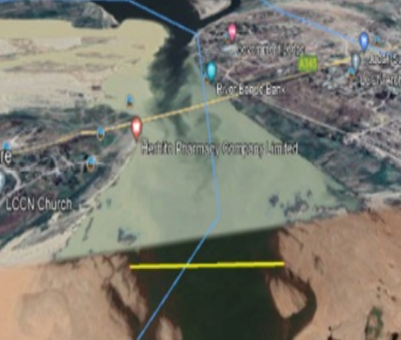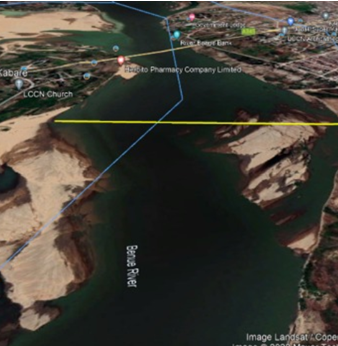By Akinyemi Akinyugha | In the second week of September 2022, massive flooding was reported in Nigeria arising from an overflow of the River Benue, affecting states on the river path from the North East to the South East and the Niger Delta parts of the country. The flooding got worse in October and may stretch into November. Initially, discharge of excess water from the upstream Lagdo Dam in Cameroon was identified as the cause of the flooding. However, the Honourable Minister of Water Resources, Engineer Suleiman Adamu, later clarified that the flooding occurred as a result of torrential rainfall overwhelming the River Benue and its tributaries.
The number of people affected by the flood is still being documented. As at the last count, the National Emergency Management Agency (NEMA) reported that 2,504,095 persons are affected by the flood, with at least 500 people declared dead.1
Enough evidence abounds that a significant portion of Nigeria is flood-prone. Though the tally is not fully in, the flooding this year will rank among the worst in Nigeria’s history, probably on the same scale with the 2012 episode. Unfortunately, this won’t be the last and future occurrences may be worse, given changing weather patterns. Finding proactive and sustainable solutions, rather than episodic and reactive responses, to Nigeria’s perennial flooding challenge is thus an urgent imperative.
How does flooding occur?
The glossary of the latest Intergovernmental Panel on Climate Change’s Special Report on Managing the Risks of Extreme Events and Disasters to Advance Climate Change Adaptation (IPCC SREX) defines a flood as “the overflowing of the normal confines of a stream or other body of water, or the accumulation of water over areas that are not normally submerged.”2
Floods occur when excess water inundates a particular watershed. As the name implies, a watershed is an entire area of land that “sheds” or drains water into a specific waterbody. Most river system are dendritic, with several streams connected as funnels to recharge water into the river. Watersheds vary in size and characteristics: they can be small or large.
When intense rain falls over a small watershed, particularly in urban areas where there are many concrete and other impervious structures, flash flood occurs. Its effect is usually exacerbated when there are poorly maintained, clogged drainages and channels.
However, in large watersheds such as River Benue, flooding occurs in two major ways. First, it occurs when significant water is discharged from an upstream dam e.g., Lagdo Dam in Cameroon. The second is the more frequent reason: flooding arises when torrential rainfall occurs in the highland areas and tributaries serving the river. The resultant effect is the inundation of the river channel and its adjoining communities. A demonstration of the scale of flooding that occurred this year is shown in the satellite image below which compares two satellite images of upstream section of River Benue in Numan, Adamawa State in January and September 2022.The images show a 2.5-times increase in the width of the river channel as a result of flooding.

A section of Benue River at Numan, Adamawa in January 2022 (about 400m wide)

Same section of Benue River at Numan in September 2002 (1020m wide)
To solve the perennial flooding crisis, Nigeria needs a big and bold visionary programme like the Netherland’s Delta Works and River Room programmes
In 1953, the Netherlands was flooded by water from the North Sea, leading to the inundation of approximately 9% of farmlands and causing 8,361 fatalities. In response, the Netherlands Government launched a massive flood protection programme, the Delta Works, whose main objectives were to protect the Netherlands from high water, ensure sufficient supply of freshwater and make the country climate-proof. The project comprised 13 dams as well as 10,250 miles of dikes, levees and barriers to protect areas within and around the Rhine-Meuse-Scheldt from flood. This ambitious $5bn works, which lasted for 24 years, ensured that Holland, despite being a low-lying country, is extensively protected from flood and has continual supply of drinking and irrigation water. The risk of flooding was reduced from the typical one in 100 years to one in 4,000 years3.

Nigeria needs its own version of the Delta Works and River Room programmes and should set out a big and bold vision for a climate-smart integrated water resources management, which seeks to turn this environmental disaster into a blessing.
Currently, the main agencies empowered by law to act on flood control and watershed management at the federal level are the River Basin Development Authorities (RBDAs). However, these RBDAs appear to focus on water resources management from the prism of agricultural utility of water and have largely played a bit-part role in flood management. Other relevant entities of government such as NEMA (under the Federal Ministry of Humanitarian Affairs and Disaster Management, and Social Development),the Nigeria Hydrological Service Agency, and the Nigerian Meteorological Agency mainly carry out predictive and reactive activities.
To galvanise action, we need a special Presidential Committee for National Flood Risk Management, which shall draw membership from indigenous and global water resources and environmental management experts, with active support of all the ministries, departments and agencies relevant to flood risk management. The committee’s mandate will be to develop a comprehensive national flood risk assessment and management programme, which takes into cognisance predicted climate change scenarios for the country. The committee will develop specific recommendations on which combinations of natural and built flood management interventions are best suited for the major watersheds/river basins and provide a cost estimate as well as strategic execution plan for these interventions. Backing the committee’s recommendations with appropriate legislations and guaranteed funding would ensure sustainability of the proposed interventions over the febrile and sometimes unstable political and budget circles of Nigeria.
Already, in October 2022 the Federal Government has approved a National Emergency Flood Preparedness and Response Plans to mitigate and reduce the impact of flood but it is unclear if this plan contains a comprehensive flood risk assessment and management plan for the country.
The solution to the flooding crises can be found in a combination of grey and green infrastructure
Finally, in developing the interventions, we must resist the notion that we can dam away all the “damned” flood waters, based on the philosophy that only concrete and steel infrastructure – dams, levees, dykes, barriers, etc. – can effectively deliver flood risk management. A combination of grey and green infrastructure will be required to deliver sustainable, climate-proof outcomes, considering the diverse ecosystem in Nigeria.
As many have suggested, the Dadin Hausa Dam, conceptualised in the late 1970s as the recipient dam for Cameroon’s Lagdo Dam, may have mitigated the flooding experienced in these communities. While this might be true to some extent, the solutions to perennial flooding goes beyond concrete structures. In the face of threats arising from climate change, nature-based solutions or natural flood management are the most sustainable alternative due to the potential ecosystem benefits they deliver over concrete and steel structural solutions.
Water, they say, will always find its level; hence, at the minimum, it is important that natural flood plains be restored to give enough room for rivers to flow before considering the introduction of dams. This will reduce downstream river flow and inundation of low-lying communities. In addition to dredging rivers where necessary, secondary channels and lakes can also be created to divert some water off the flood paths. Watershed-based forest regeneration, particularly around hillsides, should be carried out to slow down runoff from the hills into the rivers.
At the sub-national level, state and local governments need to be more committed to climate-smart land use planning and development. A revolution in our urban development philosophy and practice to allow for ecosystem-friendly development is long overdue to accelerate mitigation of the impact of extreme weather events, predicted to happen over the next few years.
Since floods occur when excess water flows above a watershed’s drainage capacity, urban development that slows down, soaks and spreads flood waters should be encouraged. This can be achieved by encouraging the use of rain gardens and vegetation over concrete pavements in private residences. Housing developers in flood prone areas should also be made to demonstrate flood-resilient aspects of their designs before permits are issued.
Sub-national governments should prioritise restoration of wetlands whilst banning any development on them while urban greening initiatives should be encouraged. Basic flood management measures including the regular clearance and maintenance of channels and drainages should also be carried out.
More ambitious countries like China have created several sponge cities within their highly urbanised city-clusters: sponge cities are large green spaces(such as trees, gardens and parks) within main cities, acting like a sponge to soak flood water and gently releasing the water into the environment. An example of a similar space in Nigeria is the Lekki Conservation Centre, Lagos. More of such green spaces should be created in areas prone to flooding.
Whatever solutions would be adopted, there is an urgent need to act decisively to institute a robust, risk-based flood management system in Nigeria. The cost of doing otherwise is better imagined than experienced; hence, the time to act is now.
Dr. Akinyemi Akinyugha is the Ekiti State Project Coordinator for the Nigeria Erosion and Watershed Management Project (NEWMAP). He holds a PhD in Engineering (Environmental/Geo-Technical) from the University of Cambridge, UK.
Footnotes
[1]https://www.thisdaylive.com/index.php/2022/10/17/nema-2-5-million-persons-affected-by-flooding/
[2] IPCC, 2012: Glossary of terms. In: Managing the Risks of Extreme Events and Disasters to Advance Climate Change Adaptation [Field, C.B., V. Barros, T.F. Stocker, D. Qin, D.J. Dokken, K.L. Ebi, M.D. Mastrandrea, K.J. Mach, G.-K. Plattner, S.K. Allen, M. Tignor, and P.M. Midgley (eds.)]. A Special Report of Working Groups I and II of the Intergovernmental Panel on Climate Change (IPCC). Cambridge University Press, Cambridge, UK, and New York, NY, USA, pp. 555-564
[3]Delta Works Flood Protection, Rhine-Meuse-Scheldt Delta, Netherlands. Accessed online: https://www.water-technology.net/projects/delta-works-flood-netherlands/



